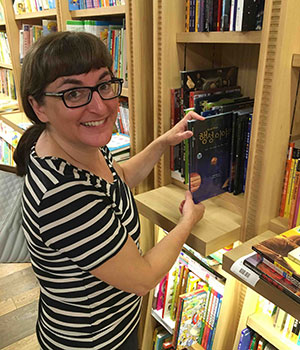Joan Marie Galat guides readers through the night sky with new book

Joan Marie Galat’s new book, Stories of the Aurora, is a fascinating, fact-packed reminder that we’re really never at risk of getting bored.
Thanks to the night sky – the subject of the author’s Dot to Dot in the Sky series – we have an endless source of “free entertainment,” says the Biological Sciences Technology - Environmental Sciences grad (class of ’84).
“I think everybody’s missing out if they don’t look up.”
Galat’s fifth and latest Dot to Dot book, released in November and written for ages 9 to 13, explores one of the most animated examples of celestial spectacles – the northern lights (as they're known when viewed from the Northern Hemisphere).
It’s part of her ongoing effort to make astronomy and other sciences understandable, accessible and, just as important, captivating.
Science and stories
The trick, she says, is to strike a balance between facts and fun. In Stories of the Aurora, Galat blends science with the tales that emerged over millennia to explain it. When planning the book, she says, “I couldn't help but wonder: what did ancient cultures think when they saw the lights?”

Galat reveals a range of reactions. Throughout history, the lights have been seen as omens good and bad, appearing before the 1941 attack on Pearl Harbor, the birth of a Chinese emperor in 2600 BC and in advance of a 16th century English rebellion. Across ancient cultures, explanations tended to include elements of the afterlife and the antics of gods.
Without sparing technical details, she makes the science of the aurora just as interesting. Kids – and adults – will come away from the first 2 chapters and sidebars throughout the book (not to mention the handy glossary) with a clear understanding of why the sky appears to light up and dance. (Spoiler alert: it has to do with the Earth’s magnetic field, but that’s just part of the story.)
The result is a guide that makes nature slightly less mysterious yet strips away none of its magic.
The power of books
“When most of us look up, we don’t really know a lot about what’s out there," says Galat. "We know about the solar system and planets and moons and satellites, but it’s so far away and so hard to fathom.”
Awards and recognition for Stories of the Aurora
- Winner, Crystal Kite Award for Canada, Society of Children's Book Writers and Illustrators, 2017
- Skipping Stones Award, 2017
- Second Place, Outdoor Writers of Canada, 2017
- Honorable Mention, Canadian Authors Association Exporting Alberta Award, 2017
- Shortlisted for the Hackmatack Children's Choice Book Award in Atlantic Canada (2017/18). Winner to be announced in May 2018.
- Shortlisted for the Red Cedar Children's Choice Book Award in British Columbia (2017/18). Winner to be announced in May 2018.
As a writer and a speaker for events at libraries and classrooms here and abroad (including a United Nations Environment Program event in Korea this summer), Galat sees that uncertainty as an opportunity.
As a young girl, she gazed at the stars while lying in a snow fort and remembers the astronomy book she relied on to explain what she saw. Looking up at the night sky has shaped a career that has been anything but boring, producing more than a dozen titles so far and earning numerous awards.
“The book you have as a child can really be powerful,” she says.
Like Stories of the Aurora, it can help explain the wonders of the world. What’s more, Galat adds, “it could build a lifelong interest.”
Joan Marie Galat's tips for viewing the aurora
Seize the moment – especially in March and late-September to early-fall, when auroras are more frequent.
Follow the darkness – on a clear, moonless night, get to an unlit spot outside the city. Let your eyes adjust for 15 to 20 minutes. If you do need to shine a light, use a red one; it won’t interfere with night vision.
Look northeast – auroras usually begin as a glow on the horizon.
Be patient – though no one can predict exactly when auroras will form, they usually appear within a few hours of midnight. They may last hours or minutes.
Stay in the know – aurorawatch.ca, operated by the University of Alberta, will send you viewing alerts by email. You can also watch for alerts on their Twitter account.